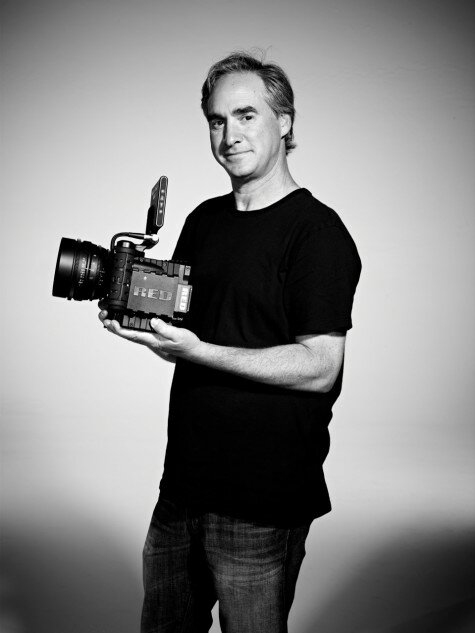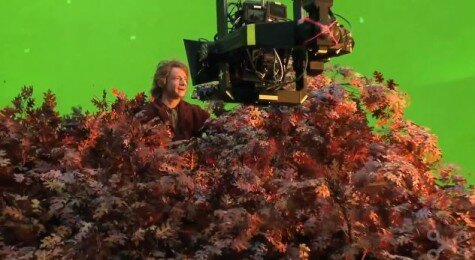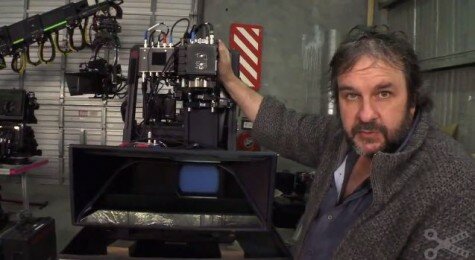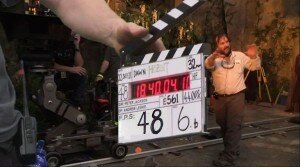“Be open minded” says Schilowitz from RED about HFR 3D

Ted Schilowitz from RED
3D NEWS> 3D FILM
With 48 5K RED EPIC cameras on the set of The Hobbit, Ted Schilowitz's company was instrumental in delivering a super smooth high fedility high frame rate experience. But against the background of mixed feeedback, Ted tells 3D Focus that viewers should approach Peter Jackson's Lord of the Rings prequels with a fresh perspective writes Max Allen.
The Hobbit: An Unexpected Journey, released December 13th, will be the first mainstream movie shot and presented at 48 frames per second. Also known as HFR (High Frame Rate), only time will tell whether the mixed reaction of preview and premiere audiences are a precedent to how future high frame rate movies will be received, or if it is simply a temporary ‘fear of the unknown’ after decades of 24 fps.
Will its hyper realism, advocated by directors such as Peter Jackson and James Cameron, become mainstream or, like 3D, a technical add on that serves a certain audience, sitting along side traditional 2D 24 fps releases?
There is no doubt that movie directors and studios will be looking closely at the public’s response to The Hobbit. James Cameron has said shooting the Avatar sequels at 60 fps depends on it: “With 3D, you’re looking through a window, and with the high frame rate, you’re taking the glass out of the window,” Cameron said in an interview. “It gives you this sense of immediacy and personal involvement in the narrative.”
Schilowitz agrees: “A lot of the industry is depending on what happens to The Hobbit and asking whether people will embrace it or love it; will they get what Peter Jackson gets? I think the biggest thing that people have to understand is you are going to have to watch this more than a few minutes to start to really understand why this is so amazing and so powerful.” He continued: “What I predict is that everyone going into the theatre will spend the first couple of minutes trying to figure out what it is and asking themselves, ‘What am I actually watching?’ If you are open minded, you will start to feel the love and the joy. All of the things that have become artifacts of historical reasons of why we shot things at 24 aren’t relevant anymore; they are only relevant because that’s how we think things should be seen.”

The RED EPIC-X can capture 5K images from 1 to 120 fps
He tips: “You are going to have to give yourself ten minutes on the minimum side up to fifteen minutes maximum of watching The Hobbit before you really start to lock in on this feature. Everyone’s making predictions on short snippets.”
There is no direct financial incentive to shoot a movie at 48 fps; there is no premium applied to a HFR ticket in addition to the 3D premium, but it is thought it could drive audiences back to 3D, with better picture quality.
One of the arguments for the decline in 3D box office is it is simply uncomfortable to watch for many, especially during fast motion sequences. As Peter Jackson says: “48 frames absolutely helps 3D because suddenly you’re removing a substantial amount of the motion blur that you get at 24 frames.” He continued: “Your eyes get a much smoother experience.”
Cameron similarly sees fast frame rates as an obvious enhancement for stereoscopic storytelling and the remedy to the confusion inducing judder of 3D fast pans “[When] audience members say they’re having eye strain and even a sense of nausea, it’s the brain shutting down when the edges of the images are strobing or juddering too much across the screen, and that’s related to frame rate.”
Schilowitz also agrees that 3D is the biggest benefactor: “At this point, 48 fps is a design choice for the 3D experience. The higher the frame rate, the more natural the 3D experience will be in terms of any kind of flickering and problems that we have with lower frame rates in 2D, so it’s a technology choice. I think we have yet to determine what the high frame rate 2D experience will be. I think that is something that will be established over time as people tune themselves to a higher frame rate experience and start looking for movies that don’t look like old fashioned movies. I think we are on an interesting cusp.”
NEVER MISS A 3D STORY – FREE WEEKLY E-LETTER SIGN UP BOX ON RIGHT
However, doubling the frame rate can introduce other issues as ‘traditional’ films are already flashed on screen at more than 24 times per second. Most digital 3D projectors (such as REALD) are based on single lens technology so each left and right image needs to be played out on screen fast enough for the human brain to merge the two images together to create a 3D effect. However, this would bring the effective frame rate down to 12 fps so 'Double Flashing' was introduced where the 48 frames (24 left and 24 right) were flashed in sequence within one second. It was found that this refresh rate was not enough to prevent discomfort so the ‘Triple Flash Solution’ was implemented, where each left and image was flashed 72 times bringing the combined refresh rate up to 144fps.
The problem is, this technique is a ‘work-around’ and does not completely eliminate flicker which shooting in native higher frame rates will do but according to Rob Engle, a 3D supervisor at a major film studio in Los Angeles, a reduction in flash rates used by single lens projectors could lead to other problems. In an article for Discovery News, Engle questioned whether the technological limitations of the projectors used by most theaters will require them to use fewer flashes for each eye before switching to the other eye’s image — a switch that could actually cause new stuttering problems.
Some theaters use a dual-projector set-up that gets around that issue by showing images to both eyes at the same time, and in those cases, Engle said, the results should be spectacular. But theaters that use a single projector to display 3D movies (the majority) will have some new decisions to make, and audiences might not be universally happy about the final product.
“You have to be careful what you wish for,” said Engle, “If you have to make compromises in order to increase the frame rate by decreasing the flash rate, you start to run into trade-offs.”
Increasing the frame rate has been tried before, but at a time when projection technology could not fully support it. Special effects supervisor Douglas Trumbull developed a process known as Showscan in the late 1970’s. It recorded and presented film at 60 fps and was intended to be used in the 1983 sci-fi movie Brainscan although plans fell through. The problem was, in the pre-digital days, no movie theatre projectors could show it, and the process was confined to theme park experiences.
Showscan as a company still exists today, and have a created a process known as Showscan Digital in association with Christie Digital Systems, which can combine frame rates within one scene. The idea behind this is to retain the film-look whilst ensuring no judder during action sequences.
VIDEO ABOUT SHOWSCAN DIGITAL
Schilowitz believes there is merit in this multiple frame rate approach: “I’ve seen experiments with this [such as Showscan Digital] and I actually put a lot of credence in that. Final deliverables can handle it so if there are certain action scenes when they want a really high frame rate experience, where there is no motion blur or artifacts, and you don’t want it to look like a historic movie, then you have that. If you want a more ethereal or traditional motion picture part of it, then you have that as well so I think movie makers will experiment with that.”
Peter Jackson is clearly a big fan of the Showscan process having said: “I couldn’t believe how immersive it was. It felt like the real world, and I thought ‘Wow, this is unbelievable…Showscan was fantastic,” But Jackson realises how it was ahead of its time: “It wasn’t viable to make a feature film at a high frame rate when every single theater in the world had a mechanical projector that could only run at 24 frames per second.”
A pioneer in high frame rate production, Douglas Trumbull is excited that, 30 years on, 24 fps could be consigned to the history books saying: “My prediction is that once people get over the initial shock of seeing something that looks substantially more realistic, they’ll see how superior it is compared to 24 frames, and that’s going to open the door toward a more immersive and spectacular cinematic form.”
The penetration of digital cinemas (which account for about 82% of cinemas in America) has meant the option of presenting movies at higher frame rates than 24 is now viable. Also, with most major Hollywood productions using RED cameras, the recording technology is there, as RED EPIC cameras can already shoot up to 120 fps at a 5K resolution. It also opens up the possibility of screening super smooth live sports events. The Super Hi-Vision standard, due to be trialled for broadcasting in 2016, requires 120 fps recording, and there is a direct correlation between resolution and frame rates – the higher the pixel count, the higher the number of frames required.

But although in theory people should prefer the look of 48 fps as it more closely resembles human vision, the feedback has been surprisingly mixed, with many complaining of an aesthetic that looks too similiar to video. Since the ungraded 10 minute presentation at CinemaCon, Peter Jackson’s team colour corrected the film to give it a more filmic look: “The whites were being clipped, and we weren’t getting the dips and the shadows, which were giving it a slightly electronic sort of video look,” said Jackson. “We’ve completely re-designed the way we convert the data from the camera into the image. The highlights and shadows roll off more, giving it a much more filmic look.”
We asked Schilowitz if be believed Peter Jackson made a mistake by showing ungraded footage at CinemaCon: “I don’t think any of this stuff is a mistake; to push this technology you have got to take some risks. I was in the audience at Cinemacon, who are not technologists primarily. They are primarily cinema exhibitors who are looking at the business of making movies. When you see something different you are going to be scared because you are wondering if you are going to capture an audience this way. Stuff was shown that was not finished so Peter gave a lot of people the benefit of the doubt, wanting to show people where he was heading towards and why it was so unique and different." He continued: "You heard a lot of noise from people who perceived that they didn’t like it or were concerned but what you didn’t hear was the silent minority who were saying this is pretty wonderful and interesting and I wonder what’s going to happen – those people don’t tend to make much noise."

Two RED Epic cameras in a 3ality Technica Beamsplitter rig
So why, after the recent premieres, has the feedback been just as mixed? People are now seeing the fully graded, final version and certain reports have echoed the comments from CinemaCon. For example, a review on Slate reads: “It’s hard to overstate the degree to which the 48 fps format interfered with my ability to get lost in this movie’s story. I should probably see it again in regular format to give it another chance.”
It is fair to say some reports of people' throwing up' have been falsified leading Jackson to set the record straight: ““No, no, that’s not true!” Jackson tells the Toronto Star: “It’s scurrilous reporting trying to make it seem there was an issue. I was at the New Zealand premiere and no one’s thrown up. Thousands of people have seen the movie and no one has thrown up.”
The Times awarded the film four stars with Kate Muir saying the use of 48 fps 3D technology give the film 'lurid clarity'. She added: "The 3-D is so relentless that my eyes watered from two hours on."
Despite a Twitter hashtag called #hobbitvomit doing the rounds, Peter Jackson is adding some balance to early reactions: “We have been screening the full-length HFR 3D presentation of The Hobbit: An Unexpected Journey extensively, and feedback has been extremely positive, with none of the thousands who have seen the film projected in this format expressing any of the issues described by two anonymous sources in media reports . . . We look forward to having audiences everywhere share in this new way of storytelling.”
TRON: Legacy (2010) director Joseph Kosinski, decided against high frame rates for his upcoming 2D sci-fi film Oblivion after tests saying: “Certainly motion is rendered better and you could say fast frame is a more realistic format, so for some things, it could make a lot of sense,” says Kosinski. “It’s one thing to watch something like a nature documentary, where the more realism, the better. But when it comes to something dramatic, it’s a different mode. My visceral reaction was that it just didn’t feel right for our story.”
Some suggest frame rates need to be increased to between 100 to 150 fps to closely match human vision but Schilowitz from Red, who's RED cameras can shoot between 1 fps and 120 fps, believes the public needs to give 48 fps a chance: “Once you get passed that 48 and above, you are achieving that immersive hyper reality that both Peter Jackson and Jim Cameron are going for.
It feels like a different style of cinema, it doesn’t feel like a traditional motion picture that we have watched for almost 100 hundred years. It’s something completely new. The way I describe it is it as significant as the change from black and white to colour; that’s how big this is. You have to think big and very open minded about this because you could probably track this conversion back to the forties and fifties when people were talking about the feel/style of movies in black and white verses the experience in colour – it wasn’t as refined as what we have now but conceptually look at what we do when we paint a colour palette.
We don’t see the world in black and white, we see the world in colour so over time, colour became a mainstream tool and black and white became an artistic but relevant choice. There is no right or wrong about any of this. Both Jim Cameron and Peter Jackson embrace and understand this technology [HFR] better than any other people I have met and they know that looking forward is the right way to approach this; being stuck in time is not. They think about their audience experience and they are putting a bet on that the audience is going to be just as intelligent, forward thinking and open minded about a new way of seeing the world as they are.”
Perhaps nervous of a 3D style backlash, Warner Bros. is being cautious with the HFR release, confining a HFR release to 450 theatres out of a possible 4000 in America. In the UK and Europe, Odeon and UCI will release The Hobbit 3D HFR in 100 screens. Dan Fellman, president of domestic distribution for Warner Brothers told the L.A. Times, "When you have something new, you want to make sure it works. This is unique, it’s different and we’ll have to see how people adjust to it."
One of the greatest challenges for filmmakers using 48+ frame rates will be to ensure the sets are suitable for the extra clarity. It was the reason Eastenders was delayed going HD as the set had to be completely transformed. There were similar concerns on the set of The Hobbit.
Speaking on The Hobbit video blog, Ann Maskrey, Costume Designer said: “I've never worked on a film before that’s 48 frames per second and uses the cameras that we are using. It’s challenging to look for fabrics that work. I know full well that a dressing gown we bought ages ago for Bilbo would probably make people feel sick if they saw it on camera. It would be like someone throwing stones in your face.”
Other changes on set included make up according to Tami Lane, Prosthetics Supervisor who said: “3D 48 frames is pretty unforgiving and we have to change the way we go about colouring these things because what we found out in early tests is if there wasn’t enough red in these pieces they would punch up yellow and react differently to normal skin with blood flowing through it.”
Despite a resistance by some, do we really want to stick at 24fps? Would that not be like sticking to black and white or stereo sound? As Pater Jackson says, the reason for choosing 24 fps was not for aesthetic reasons: “Silent movies were shot at somewhere between 16 and 18 frames per second (fps) with hand-cranked cameras. In 1927, when sound came along, the industry needed to agree on a motor-driven, constant camera speed. 35mm film stock is very expensive, so it needs to be as slow as possible. However, the early optical soundtrack required a minimum speed to achieve fidelity of the sound. 24 fps was decided on, and became the industry standard for over 80 years, with cinemas all around the world installing mechanical projectors only capable of projecting at 24 fps. 24 fps was a commercial decision — the cheapest speed to provide basic quality — but it produces movement artifacts, like strobing, flicker and motion blur. Now, in the digital age, there’s no reason whatsoever to stick to 24 fps.
Also, it is worth noting, that there has been lots positive feedback too. One theater exhibitor raved, "This is a much more immersive, sharp and engaging experience. It feels like you’re right there."
Film magazine Total Film is one of the most praising – giving the film five stars and saying: “It’s a delicate balance between, on the one hand, sing-songs, camomile tea and cute, ailing hedgehogs; and on the other, lopped limbs, chilly hints of evils to come and wild-eyed wolf-monsters that get right up in the viewer’s grill thanks to Jackson’s 3D."
Jon Lyus from movie website HeyUGuys is equally impressed saying: “There will inevitably be much discussion of the higher frame rate of 48fps, but it is certainly worth seeing this film in this format if you can. It is a jarring experience, when we see Bilbo scurrying through Bag End I genuinely thought the film was being played at double speed. The clarity and detail which appears when this visual conflict settles down (which it does quickly, though not completely) is astonishing." Full The Hobbit HeyUGuys review here.
Hugh Hart from Wired magazine goes even further saying: "At 48 fps, images appear more precise and 3D action becomes smoother, without the blur that can occur when the camera pans too quickly or objects move rapidly across the frame."
Looking to the future, Schilowitz believes movies will evolve into ‘experiences’, as television competes with larger screens and 4K resolution. Increasing resolutions (RED will soon be releasing their 6K Dragon processor upgrade) and frame rates will be part of that cinema draw: “Do you want technology to always push the envelope, even if we don’t know what the envelope is going to be or what it is going to look like in the future or do you want to just sit back and say ‘that’s good enough’ – I think you know the answer to that question."
He continued: "When you look at the cinema experience, is there a good end to this? I think the answer is no – any perceived end is just a limitation. He continued: "There has always been this battle between what do I pay to go to the movie theatre for verses what can I get at home and I think the ante keeps going up and up and up. Pictures at home now can rival cinema so cinema has to be better and that’s what Peter is looking at with 48 frames and Cameron with 60 frames. We want bigger bigger more immersive experiences when we go out to pay for a movie. It needs to be more like a ride than a movie and that’s what people want.”
As always, you should judge for yourself. The Hobbit: An Unexpected Journey is released nationwide on December 13th, in HFR 3D, IMAX 3D, RealD 3D and 2D!
For more information about RED visit www.red.com.
FREE WEEKLY 3D NEWS BULLETIN –




















